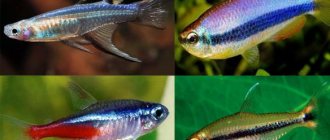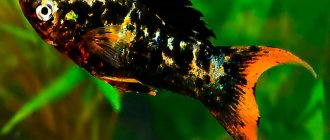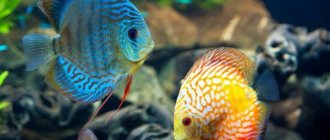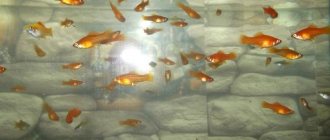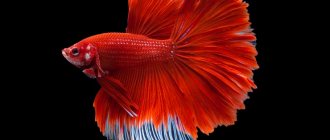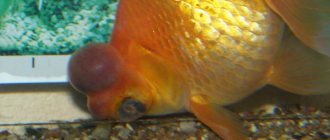Neons are small fish belonging to the characin family. The natural habitat is the entire Amazon River basin. The species got its name from the bright stripe that runs along the spine and resembles a neon glow. They have a peaceful nature, and therefore can easily get along in the same aquarium, both in a school of fish of their own species, and with some other species. For example, neons have the most favorable compatibility with platies, catfish, and guppy fish, since none of them will harm each other.
Danio fish description and photo
If we talk about Danio in the context of decorative aquariums, then here the fish is favored by its richness of colors, peaceful disposition and ability to enliven the atmosphere in the aquarium. A bright flock of 7 or more individuals will fit perfectly into an aquarium with equally peaceful kids. Shimmering with multicolor, constantly playing in the upper layer of water, and in the case of GloFish, literally glowing with enthusiasm - Danio is an excellent choice for revitalizing and filling a beginner’s aquarium.
Table of basic parameters of maintenance, care and nutrition:
| What should be the volume of an aquarium for Danio? | from 30-50 liters for a school and from 120 liters for Malabar Danio |
| What should be the temperature in the aquarium for Danio? | from +20-26 °C |
| What pH should be in the aquarium? | from 6.5-7.5 pH |
| What should be the hardness of the water in the aquarium? | from 5-18° dH |
| What should be the substrate for an aquarium? | any |
| What kind of lighting should be in the aquarium? | 0.5-0.8 Watt/l daylight for at least 12 hours |
| What should be the movement of water in the aquarium? | moderate |
| Maximum fish size | up to 6 cm, Malabar Danio up to 12 cm |
| What does aquarium fish eat? | dry food, daphnia, tubifex, bloodworms |
| Type of aquarium fish | non-aggressive |
| Who is compatible with in an aquarium? | get along with small non-aggressive fish species; not compatible with shrimp |
| Lifespan of Danio | from 3-5 years, depending on the size of the individual |
Who can neons get along with in the same aquarium?
Home / Fish / Compatibility / Who can neons get along with in the same aquarium?
If you are just planning to start your first aquarium, then most likely you will have many questions: how to prepare the water, and what kind of soil to use. What decorations can be used and what plants can be planted. What equipment is better and what kind of fish to stock.
And when it comes to residents, you can’t help but think about how different types of fish will get along together. Today we will look at how neons and zebrafish will get along in the same aquarium, and who can potentially be added to them.
Neons
When you go to any pet store, with a high degree of probability you will notice these little blue lanterns, which will peacefully swim in a flock in their aquarium and shimmer in front of you with their bright bodies with amazing colors.
These little ones represent the Kharacin family. In their natural habitat, these are very mobile and nimble creatures that will outwit any predator when maneuvering in dense vegetation.
The size of these fish does not exceed 3 centimeters, and their life expectancy, which depends on the conditions of detention, can be from 1.5 to 5 years. Kindness is our everything - this is how you can describe this fish. They stay very peacefully within their flock and will not show aggression towards their neighbors.
Speaking about the compatibility of these fish within the same aquarium, we need to start from the very beginning. Before you plan what types of fish will coexist in your aquarium, you need to plan your aquarium. Neons, as such, do not need a large volume of water. But this is only if you keep 3-4 individuals.
Schooling fish will begin to reveal all their behavioral beauty from 10-12 individuals. In small numbers, neons, in fact, like zebrafish, will not have school instincts that awaken, but when there are about a dozen of them, you will not recognize your neons.
Instead of languid movement around the aquarium, you will witness the rapid establishment of a leader in a flock, a flock mind, and simply a beautiful synchronized and organized movement of your luminous crowd. Agree, but it will be a completely different sight.
And if you do decide to keep a small flock, then you should think about the fact that they will need quite a lot of space to maneuver. In this regard, neons are very similar to zebrafish - the more the aquarium is extended in length, the more active the schools, both the first and the second, will behave.
If we expect that we will have 10 neons, then they will need a reservoir of at least 50 liters. But then our main question comes into force - who will be neighbors with them.
Danio
Danki are fish that arrived in the vastness of our country from Southeast Asia. In their homeland, these crumbs usually scurry between plants and stems of bank grass, which sinks into the water of standing and slow-flowing rivers. Small invertebrates of these reservoirs are the favorite food of zebrafish.
Danios, like neons, have become very widespread in freshwater aquariums in our homeland due to the fact that they are very peaceful and unpretentious in keeping. They can live, like neonfish, in fairly small aquariums.
They try to stay in the middle layers of water, but more so in the upper layers of water. When playing or being afraid of danger, zebrafish can jump out of the aquarium, so you need to take this moment into account and cover the aquarium with either glass or a special lid.
Danio is a schooling fish. The mechanism of their school behavior is activated when there are about 10 individuals. In this they are very similar to neons. The aquarium is preferably longitudinal, and the larger it is, the more interesting it will be for you to watch the games of these fish.
Aquarium decoration
And when we have decided that we will have a flock of neons and a flock of zebrafish living in the aquarium, we can begin to plan their home. For such a group, it is advisable to take an aquarium from 130 liters. There is simply no upper limit on volume.
The larger the body of water, the more comfortable it will be for its inhabitants. What do we need to know? Neons prefer to stay in the middle layers of water, zebrafish prefer the upper layers, but they also feel comfortable in the middle layers. This means that we comply with the first indicator - the fish will not huddle in the same territory.
We have chosen the volume and now we need to start planning the equipment of the aquarium. Besides the fact that, like in a regular aquarium, we need a filter and a heater, we also need to think about the aesthetic component of our pond.
Neons and zebrafish in their natural habitat live in shaded ponds. As you might guess, it is against a gloomy background that the coloring of these fish will look most advantageous.
The same idea should be followed when choosing decorations. These fish look great against the backdrop of granite ruins, from which low-growing aquarium plants will grow.
When you plan your aquarium, do not clutter the central part with massive castles or other decorations. It is in this part of the aquarium that neons and zebrafish will feel most comfortable. It is better to place castles and grottoes in the end parts of the aquarium. You can also plant tall plants there.
There is no doubt that under such conditions your neon squad will get along well with zebrafish. But what if you eventually want to add fish to your aquarium?
Compatibility with other fish
The most ideal neighborhood for neons and zebrafish is viviparous fish.
Neons and swordtails will feel great together, just as they will be wonderful neighbors with guppies, platies and even mollies. All viviparous animals are peaceful, unless it concerns intraspecific disputes between males when it is time to reproduce. But these moments will not be reflected in the neons. Neons and shrimp are completely compatible. This neighborhood can even be called beneficial, since shrimp are excellent orderlies. The remains of uneaten food, which the neons may not be able to collect between the stones, will be cleaned up by the shrimp. Moreover, shrimp occupy the lowest layer of water, and due to their lifestyle, they will almost never intersect with neons.
Labyrinths are also excellent roommates for neons. Cockerels, gourami lalius and macropods will rarely pay attention to the kids who are scurrying everywhere non-stop, and will simply go about their business.
Full compatibility table.
An exception in this case can only be when a pair of labyrinths decides to breed in a common aquarium. When the male builds a foam nest at the surface of the water and, after spawning, lays eggs there, he can drive away neonfish swimming past, but you shouldn’t expect much aggression from labyrinths in a large and spacious aquarium.
Neons and angelfish in the same aquarium are a rather dubious pleasure. Angelfish fish are very territorial, and if a pair of angelfish has chosen a secluded corner, then any attempt to penetrate there will be accompanied by serious aggression.
This situation can be corrected if the angelfish are introduced into the aquarium when they are very small. Angelfish that grew up with neons will not defend their territories so aggressively.
Are there any fish that neons don’t get along with at all? Of course have. One type of fish that Neons will not be very comfortable with are large fish. If you take large cichlids, such as cichlids or astronotuses, then butu neons are regarded as food and will quickly cease to exist in the aquarium.
Who doesn't get along with a good-natured goldfish or a beautiful koi carp? It just doesn’t get along with neons. Although without a hint of aggression, the fate of the neons will be exactly the same as in the case of cichlids. A small fish swimming past the mouth will be swallowed.
Conclusion
Neons will feel comfortable with almost all fish.
Exceptions will be:
- predatory catfish, which will be many times larger than neon;
- angelfish, which can quite fiercely defend their possessions;
- goldfish and koi carp, which can simply swallow a small fish swimming past their mouth;
- large cichlids that will hunt neons, regarding them as food.
And if you forget the information from this article, then you can always refresh your knowledge and the aquarium fish compatibility table will help you with this.
(1 ratings, average: 5.00 out of 5)
zootyt.ru
Danio care and maintenance at home
Danios are not very demanding to care for, and are therefore recommended for beginners. It is enough to choose an aquarium that meets the optimal requirements for water and light. Periodically replace the water in it with settled water. And of course, don’t forget to feed, but don’t overfeed. Reproduction of Danios in captivity is simple and fast, which is why they are also loved in the scientific community as experimental specimens.
Potential neighbors
Experts note that the best neighbors for a pugnacious betta will be fish with a Nordic character. They choose non-aggressive ones, in which case there will be no fights. The best combination of cockerel with catfish, fishtails, swordtails, tetras, macrognathus and zebrafish. They can also be recommended for aquariums that already contain gours, ornathus and iris.
Mollies
Cockerels get along best with mollies. This fish has the exact opposite temperament. Mollies do not have a bright color, but the cockerels will look great against its background. However, if when baby fish appear, they must be moved to another aquarium - otherwise they will become prey for the betta.
Botsiya
Botsia fish are also quite often sent to the cockerels. But in this case, special attention is paid to shelters and decorations. So that the warrior can sometimes take a break from her active comrade. It is advisable that there are at least 3-4 bots in the aquarium.
Ancistrus
Also, quite often, bettas coexist with the sticky catfish. It is distinguished by its dull color, but its unusual shape. However, despite the external differences, ancistrus and betta have the same preferences for living conditions. They both love fresh water, but cannot tolerate salt water. To make the neighborhood pleasant, the aquarium owner will have to take care of installing algae.
Gourami
Gouriki will be excellent companions for cockerels. They coexist and do not quarrel only if there is a large space, so the aquarium should be bulky. At the same time, they are also active and slightly explosive in nature. The surprising thing is that this does not cause problems.
Corridors
Opposite in character are Corydoras catfish. They are always calm, able to “calm down” even an irritated rooster. A wonderful feature is that they live at the bottom, cleaning it. For the aquarium owner, this is only a plus, since the costs and time required to care for the aquatic world will be reduced. Individuals of these two species are kept without shelters or decorations; aquatic plants are also not required.
Neons
Neons also live peacefully with bettas. But often the discrepancy between the temperature characteristics makes their maintenance not the most convenient for the aquarium owner. The ideal temperature for this tandem is 24-25 degrees - the lower limit for roosters and the upper limit for neons.
Rasbory
It is quite possible to keep cockerels together with rasboras. These fish are more buoyant and maneuverable, so even if attacked by an aggressive neighbor, they can escape from him. Algae or shelters are required to limit movement.
Tetras
Tetras are very similar to bettas in temperament. However, this does not in the least prevent them from coexisting quite peacefully. Tetras move in flocks, and bettas do not risk attacking them in such numbers.
Cardinals
Cockerels may also coexist with cardinals. The fish are small and inconspicuous. Cockerels simply do not consider them as rivals, so they can move around in the aquarium as they please.
Snails
Snails are also allowed in the aquarium with cockerels. But they must be adults. Small specimens will be used as food for fish.
Fish in a Jar does not recommend keeping aquatic organisms in spherical and cylindrical containers!
What to feed Danio
Danios are unpretentious in food, but still it is worth making a bias towards floating food. Daphnia and bloodworms are very good options. When choosing between dry and live/frozen food, the latter will be preferable due to its positive effect on the color of pets (this essentially applies to most types of aquarium fish). However, today, among the dry food from popular manufacturers, flakes have already appeared, designed specifically to enhance the natural color. Good results are obtained: tetra pro color, tetra rubin, tetra fill, sera red parrot.
Life hack: simple dry food soaked in carrot juice also gives good color results).
You need to feed twice a day, in fractional portions, removing the remains of uneaten food.
Consequences of incorrect placement
If the aquarist has not taken into account the recommendations for the cohabitation of fish, then conflicts may arise among them.
Important! Swordtails or their neighbors become victims of the aggressive behavior of stronger individuals.
Oppressed fish can be recognized by the following signs:
- they refuse to eat;
- swim slowly and poorly, do not come out of hiding;
- get sick easily due to loss of immunity.
If you let the situation take its course, conflicts will occur with even greater force, so that the weakest fish may die. The compatibility of different species is relative, since the peaceful existence of fish in one territory depends on many factors.
Perhaps the aquarium is too crowded, or the balance between males and females within the school is imbalanced.
To correct the situation, it is necessary to remove some of the fish and analyze how the behavior of the remaining individuals will change.
In addition, it is worth remembering that between some species a friendly neighborhood arises only if they grew up together. Adult fish often react to the introduction of “strangers” with great aggression.
Popular Danio Species
There are several species of Danio that are most popular among aquarists:
Danio rerio photo
The most common subspecies. Grows up to 7 cm. The color is silver, with blue stripes. It is from Danio rerio that the genetically modified variety GloFish was bred.
Danio malabar photo
The average size is 10 cm. Individuals 12-15 cm are often found. The color is silver, has a greenish line along the body, with lemon splashes. Unlike other representatives of Danio, it requires an aquarium with a volume of 120 liters or more.
Spot Zebrafish
Size from 4 to 5 cm. It has a white-golden color with an olive back and black stripes crossing the body. Below the stripes, the body is dotted with black dots, which influenced the name.
What kind of aquarium is needed for zebrafish?
The habitat, if we are not talking about the Malabar giant, is an elongated aquarium from 30 to 50 liters. For all other species of Danio, a small aquarium of 10 liters or more is suitable. Considering the general mobility of Danio, it is worth equipping such an aquarium with a lid to avoid jumping out.
Danio has no special requirements for soil fillings and this applies to all varieties. Stones, sand, and artificial types of soil are suitable. The only thing that should be done is to pre-sterilize the soil by calcination or boiling.
If the aquarium is planned to be planted with living plants, for example, various types of sagittaria, Vallisneria nana, Vindelova fern and many others. It is better to select the soil not for Danio, but for specific types of plants. The fact that bright, saturated colors look great in an aquarium with Danios also speaks in favor of living plants. The same GloFish with their florescent colors, briskly flying over the emerald forest, create the atmosphere of a completely different world, a wild and uninhabited planet from a science fiction film.
Plants that are perfect for:
- glossostigma;
- sitnyag;
- marsilia quatrefoil;
- saggitaria;
- Java moss.
Java moss, a favorite among aquatic designers, can also be placed along walls or driftwood - it will look very beautiful and will not interfere with Danio playing near the surface.
Water for an aquarium with Danios must meet the following characteristics:
- temperature from +20-26°C;
- hardness from 5-18° dH;
- acidity from 6.5-7.5 pH;
- Regular water renewal (up to 30% weekly) should help maintain these parameters optimal.
Living in flowing reservoirs, Danios are demanding on water quality, cleanliness and high oxygen saturation. You should select a filter and compressor that are suitable in terms of power. It is better to set the current level to moderate. It is also necessary to install bright lighting at a rate of 0.5-0.8 Watt/l.
By type
As already noted, Danios have a peaceful and lively disposition. As a rule, they constantly swim in the upper layer of water, which should be taken into account when introducing other species.
Another important feature is the school nature of Danio. They must be kept in a group that includes at least 6 individuals. If there are fewer fish, they will begin to get nervous and show unusual aggression.
This factor also needs to be taken into account when populating an aquarium: the total number of fish, both Danio and their neighbors, should not be excessively large, since crowding negatively affects all residents of the aquarium and easily leads to the development of various diseases in Danio.
Guppy
Guppies are one of the most suitable species that can coexist with Danio. The fact is that these fish have similar requirements for living conditions (water parameters, lighting, feeding, and so on). In addition, the “guppies” do not show aggression, just like Danio towards them. Such a neighborhood will not bring any trouble to the aquarist and will please his eyes, since the fish are harmoniously combined with each other.
It is important to note that Guppies can only be added to an aquarium whose volume exceeds 40 liters. As a rule, there are about 2.5 liters of water per Guppy. If kept more closely together, constantly moving Danios can harm their neighbors, and the quality of the water will decrease significantly, since there will be too much waste in it.
Barbs
Barbs are an extremely undesirable option for joining Danio. These fish are distinguished by aggressive behavior, which extends even to large neighbors. Small species (such as schooling fish) will not be able to live with Barbs at all.
Predatory neighbors will constantly intimidate small individuals, which will lead to stress, loss of color and even death. Some aquarists believe that Danios can hide in shelters located on the ground, but this still will not relieve the fish from constant stress.
In addition, many Barbs like to live in old water, which is not suitable for keeping Danios. Thus, proximity to Barbus is acceptable, but highly undesirable.
Ternetia
Another species that sometimes shows aggression towards other fish. The proximity of zebrafish with veil fins is especially undesirable, since Ternetia likes to tear off such fins.
At the same time, Ternetia are quite peace-loving and playful fish that can easily live together with Danio, not paying attention to each other. They have similar taste preferences and requirements for water parameters, so aquarists are advised to do a test stocking and observe the behavior of the fish. If no conflicts occur, then Ternetia can be left in the aquarium.
Cockerels
Like Ternetias, they can be aggressive towards species that have long, veiled fins. If you get classic Danios, then the likelihood of problems occurring is minimized. Cockerels, as a rule, get along well with schooling fish, and from the outside their combination looks very harmonious.
Angelfish
Surprisingly, Danios can be kept with Angelfish, but only if both species have grown together. When adult individuals are introduced, large Angelfish often perceive small fish as food and willingly eat them.
Swordtails
Although Swordtails are fairly large fish, they rarely behave aggressively towards schooling fish. The cause of possible aggression can only be overcrowding of the aquarium, since in this case there is an inevitable struggle for territory.
Neons
Like Guppies, Neons are an almost ideal option for joining Danio. This species has similar taste preferences and requirements for water parameters, as well as similar behavior: high mobility and peaceful disposition.
Neons get along well with both classic and veil specimens, and their external combination will please any aquarist.
Who do zebrafish get along with?
Being a peace-loving fish, Danio gets along well with most small and non-aggressive fish: Guppies, Neons, Platies, Mollies, Swordtails, Norman's Blueeyes, rainbow fish and others. However, you should not add him to larger fish, which Danio can easily become a victim of.
Separately, it is worth noting the undesirability of keeping Danio together with aquarium shrimp, the young of which are a delicacy for Danio.
Lifespan of an aquarium fish Danio
The lifespan of Danio is from 3 to 5 years, depending on the size of the individual. Larger individuals measuring 10 cm or more live longer.
Everything about the compatibility of zebrafish with other inhabitants of the aquarium
Home / Fish / Compatibility / Everything about the compatibility of zebrafish with other inhabitants of the aquarium
Danios and neons in the same aquarium? Is that possible? Danio can rightfully be called one of the most frequently encountered inhabitants of the aquarium world. This fish is very unpretentious in keeping and caring for it is not difficult even for a beginner.
This species is also peaceful in nature and has virtually no problems living together with other aquarium fish. And yet, we will try to consider in more detail the features of the neighborhood of this species with the same neons, guppies, cockerels and other popular inhabitants of aquariums.
Zebrafish: character traits and external species relationships
As already noted, zebrafish in general can be described as a very friendly, peace-loving fish.
By and large, the negative compatibility of zebrafish with other fish species can be influenced by only two main factors, namely:
- pronounced differences in requirements for living conditions;
- a natural threat to this species from larger and more aggressive fish by nature, especially predators.
That is, we can conclude that with the vast majority of other aquarium inhabitants, “danichki”, due to their non-conflict nature and natural lack of interspecific aggression, can coexist quite well in a common aquarium, without creating headaches in this regard for their owners.
The only known factor that can affect the peacefulness of zebrafish and give the behavior of this species traits of aggressiveness is an insufficient number of individuals in the aquarium.
When buying fish of this species, you should remember that these are schooling fish and, depriving them of their natural need to campaign for their own kind, you can provoke stress, and thereby cause discontent in these peace-loving fish.
After all, even if we see that one individual is chasing another, this is their normal school behavior, and not aggression at all. So the need for a campaign for them is at a natural level.
We select good neighbors
So, finding a good neighbor for a friendly zebrafish will not take much time. This species gets along equally well with almost all aquarium fish that do not show aggression towards it.
The most suitable neighbors for this species will be neons, swordtails, angelfish and cockerels.
Let us separately dwell on the peculiarities of the neighborhood of zebrafish and neon fish. Danios and neons in one aquarium are one of the best possible combinations. These species share a gregarious lifestyle. They are very similar in terms of habits, and will not irritate each other with their mutual flickering.
In addition, both of them have a peaceful character. And they tend not to leave their schools, so placing 2 groups of fish of both species in an aquarium will not cause any chaos inside the tank. From this we conclude that zebrafish and neons will become the best neighbors for each other.
Angelfish can also be a good choice as neighbors for this species, but under one very important condition. These fish should be raised together in the same aquarium, then there will be no problems. If you introduce small zebrafish to already adult angelfish, the latter may perceive the newcomers as prey.
The Siamese cockerel, despite its aggressive disposition and pugnacity, will not perceive these small fish scurrying from corner to corner as competitors in the territory. Typically, betta fish practically ignore schools of zebrafish, not showing much interest in them.
The same can be said about swordtails. These fish tend to get along well with most inhabitants of the aquarium, and they also get along well with zebrafish.
The same guppies, which have the same non-conflict character and small size, will also not pose problems when living together with zebrafish in the same tank.
In addition to the above-mentioned species, “danichkas” get along quite well with such representatives of the aquarium world as:
- speckled catfish;
- guppy;
- battles;
- platies;
- lalius;
- Ancistrus;
- mollies;
- labeo;
- gourami;
- tetras.
They get along well even with aquarium inhabitants such as snails and shrimp, without mistaking them for food. Of course, better neighbors could not be imagined.
Who shouldn't these fish live with?
Now let’s take a look at the undesirable neighbors for zebrafish, and these include:
- goldfish;
- acne;
- cichlids;
- discus;
- brocade carps;
- barbs (to a lesser extent).
A goldfish will be an unsuitable neighbor for “danits” for two reasons. Firstly, this species is much larger, and if dissatisfied on its part, it can easily kill its small neighbor.
And secondly, these species have noticeable differences in the temperature requirements inside the aquarium. Goldfish are very cold-loving and prefer the temperature inside the tank within the range of 18-20 degrees, while for zebrafish the normal values will be higher, namely 21-24 degrees.
Danios should also not be housed with cichlids and discus fish. These species not only have impressive dimensions, but they are also characterized by waywardness and a desire to establish their own rules inside the tank. This is especially true for predatory cichlids, such as astronotus.
Also, to a somewhat lesser extent, but still it is worth avoiding the proximity of zebrafish to barbs. Barbs are very aggressive fish, and in this regard they are even superior to the same cockerels. Moreover, barbs are larger, and frisky, flickering groups of zebrafish can cause irritation and aggression on the part of these fish, which can lead to known consequences. But here it’s 50/50. Precaution should be taken, but quite often in spacious aquariums these fish coexist quite normally.
To a greater extent, barbs can be undesirable neighbors for such a subspecies of zebrafish as the veiled zebrafish. The barbs will definitely take hold of its silky fins and only fragments will remain of them.
By the way, there is an excellent way to save the “danish” from the persistence of the barbs. The solution is simple. You should get a few more barbs, creating a flock of 8-10 individuals. Then they will have something to do, and they will have fewer questions for other fish.
Conclusion
As we were able to see, aquarium zebrafish are indeed rightfully considered one of the most unpretentious species. They not only do not create problems inside the aquarium on their part, but also do not provoke its other inhabitants.
Their kind disposition and lack of aggression towards both their fellows and representatives of other species makes them a wonderful aquarium pet. Well, danios and neons, without a doubt, could well receive a prize for winning the “best neighborhood” category.
(1 ratings, average: 5.00 out of 5)
zootyt.ru
Reproduction in a community aquarium
Danio reaches sexual maturity at 5 months. Spawning of these fish is not difficult. It also happens well in a general aquarium, without outside stimulation. Spawning begins with vigorous courtship. Brightly colored males begin to intensively pursue females. Then spawning begins. The effectiveness of this event depends directly on the number of plants in the aquarium - unprotected eggs are easily eaten by the inhabitants. The ripening of caviar lasts 3-4 days. Next, it is still better to transplant the fry without releasing them into the general aquarium until they grow up.
Compatibility
Home / Fish / Compatibility
Compatibility is an indicator of how well one species of fish can get along with another species in the same home. For beginners in aquarium keeping, one of the most common problems is the incorrect selection of fish in the aquarium, or, more simply, incompatibility of fish.
And this is a very important condition that affects not only the appearance of the aquarium, but also the well-being of its inhabitants.
What does fish compatibility depend on?
Let's briefly look at the parameters of fish compatibility:
- The whimsicality of fish to the conditions of their keeping. It would be a bad idea to house simple and hardy fish at the same time with some exotic ones.
- Temperature. Fish are divided into cold-loving and heat-loving, so if they are placed in the same aquarium, the result will be sad.
- Different types. Adding peaceful and predatory fish to the aquarium would not be the best option. Predatory fish simply drive peaceful ones, and in a few days there will definitely be fewer fish.
- Schooling fish. If your fish is a schooling species, then you need to take several of them at once, otherwise stress and death of the fish is inevitable.
Before buying fish, first decide what you clearly want. This will avoid problems of fish incompatibility, and will make your aquarium peaceful and colorful, to your delight.
zootyt.ru
Types of diseases
With proper care, zebrafish rarely get sick. However, various infections can be introduced: by introducing fish that have not been quarantined, or by adding non-sterile soil.
Plistophora zebrafish
Loss of appetite. The presence of white spots on the body. Disheveled fins. Shiver. Removal of severely affected individuals. Disinfection of the aquarium. Adding methylene blue or erythrocycline to the feed.
Trichodinosis in fish
Grayish coating on the body. Reduced color brightness. Friction on hard surfaces. Increasing the water temperature (+30-+31 °C is suitable). Add salt to the water (1 tablespoon of salt per 10 liters of water) for a month.
Danio's bulging eyes
Swelling of the abdomen and eyes of the fish. The inside of the eyes fills with whitish fluid. Testing water for compliance with requirements. Increasing the number of water changes to a twice-daily frequency.
Character of cockerels
Bettas are popular aquarium fish from the Macropod family. The scientific name of the fish is Betta Splendens. Their character is not simple - fights between cockerels and other fish can often be observed in a shared aquarium, for which Betta was nicknamed “fighting”.
The homeland of cockerels is Thailand, where the fish live in small reservoirs with water temperatures from 21C to 27C. What is noteworthy is that the phenotype is at odds not only with other specimens, but also with representatives of its own genus. Fights can be brutal and furious, sometimes the fight ends in the death of one of the males. Females also know how to fight, but they are more lenient and friendlier to each other, so females are often kept 3-5 in one tank.
During competition with other fish, the color of the betta changes: the color saturation increases, and the fins and tail unfold, showing the Betta in all its glory. Aquarists, knowing about this feature of the phenotype, specially keep two males in one reservoir, divided into two compartments by a transparent wall. In Thailand, they even hold deliberately provoked fights between two individuals, gathering spectators and placing bets on victory. It should be noted that in such fights the cockerels do not die, but only end up with damaged fins.
Bettas fight not only with their relatives, but also with other phenotypes. The very name of the fish is reminiscent of the pugnacious nature of the birds of the same name. Despite their beauty and unpretentiousness, keeping bettas in a community aquarium can be difficult for aquarists, especially beginners.

